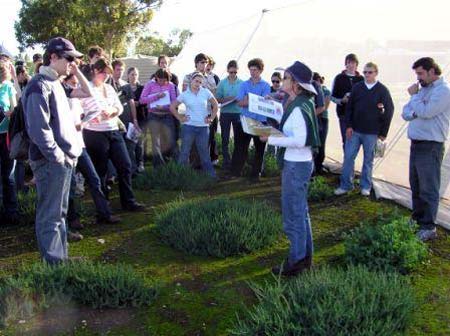|
Weeds are known to harbour pests and diseases of many vegetable crops.
Controlling weeds can often be costly, short-term and cause environmental problems such as soil erosion, raising dust and loss of soil moisture. However, leaving the weeds can provide reservoirs of plant pests and diseases.
Revegetation by Design involves the integration of native vegetation with horticultural production systems, with a focus on replacing weeds and manipulating vegetation to disadvantage plant pests at a farm scale.
This approach has shown great promise on the Northern Adelaide Plains of
SA where thrips and the diseases that they vector nearly crippled the local vegetable
industry.
This report details the survey of key native plants and weeds in the south east QLD and identifies the benefits that native plants offer vegetable growers.
Author : Nancy Schellhorn
– CSIRO
|


Key Findings :
-
Top insect pest concerns include; Heliothis spp, silver leaf whitefly, jassids, diamondback moths, and thrips.
-
Exotic weeds and grasses are most likely source populations of jassids colonising sweet corn, beans and other vegetable crops.
-
Most species of pests and natural enemies are multihabitat users, and there appears to be species-specific preference for different habitats.
-
Key parasitoids of pests and predators (some species of hover flies) are clearly using edge habitat (area between native remnants and the crop) and the native remnants.
-
Trees were the dominant native plant in the landscape in the Lockyer Valley. Insect populations were low and planting trees is often a poor revegetation strategy for weed suppression. Trees most often impede moving farm machinery and can cause havoc with irrigation systems.
-
Shrubby, low-growing plants have multiple benefits and should provide a preferred habitat for beneficial insects.
-
Replacing weeds with particular species of native plants has the potential to improve pest control for two main reasons.
- many Australian native plants are not likely to be host plants for exotic pests, hence pest populations can not develop on them.
- native plants can provide habitat (eg. shelter, alternative food and alternative prey) for natural enemies of insect pests.
This may allow for the build up of natural enemy populations close to the crop resulting in more inpiduals colonising the crop earlier.
Given that several species do use the edge between the remnant and crop means that revegetation efforts along fence lines, riparian zones near waterways and under powerlines, would remove weedy sources of plant pests and create the necessary habitat for natural enemies.
There is great promise in the adoption of Revegetation by Design to achieve long term insect and weed control, natural resource management and gaining a marketing edge by product differentiation.
Revegetation by Design is a concept that in theory has merit and wide scale public and industry appeal, but we do not have sufficient scientific knowledge to promote it for its intended primary function; pest control.
Recommendations:
Several questions need to be answered before the Revegetation by Design concept can be implemented.
- Can on-farm changes in vegetation management change pest and natural enemy dynamics or does the surrounding landscape have the greatest influence, thus always dominate any local farm management ?
- Are growers willing to adopt revegetation strategies If onfarm changes in vegetation management benefit pest control ?
- Is there a cost benefit for long-term pest and weed control using the cultural control of Revegetation by Design ?
- Do consumers identify and value links with the Australian bush and native flora, and make purchasing decisions around these issues ?
The work to date both in Australia and overseas certainly suggest that the Revegetation by Design approach is a promising and an important component of pest management and can create a market advantage.
SEE ALSO :
VG06024 Native Vegetation and Pest Control – part 2 (2008)
 VegeNote : Native Vegetation and Pest Control (2008) VegeNote : Native Vegetation and Pest Control (2008)
Acknowledgements :
The author would like to acknowledge and thank:
- Anna Marcora (CSIRO) for her excellent technical support, particularly her ability to take initiative
- Mark Wade (CSIRO), for his leadership on the project
- Maarten Vodde (Wageningen University, The Netherlands), for his hard work and deligence.
I thank Mulgowie Farms for allowing us to conduct our Malaise trap survey on their property.
Particular thanks go to Andrew Johanson and The Emmericks.
I would like to thank several people who dedicated their time even though they were not funded from the project:
- Bronwyn Walsh, DPI &F, contributed to grower meetings and workshops, including press releases and grower engagement;
- Margie Millgate, Growcom, took considerable time in helping us meet growers that are interested in the concept; SEQ Catchment staff,
- Kay Montgomery and Steve Lyngcoln were extremely helpful for vegetation assessment and identification.
This one-year project has been facilitated by the CSIRO Entomology, Horticulture Australia Limited in partnership with AUSVEG through the National Vegetable Research and Development Levy.
The Australian Government provides matched funding for all HAL’s R&D activities.
|

